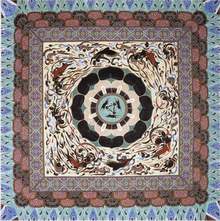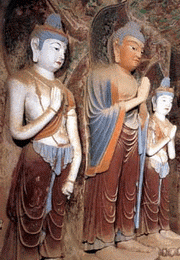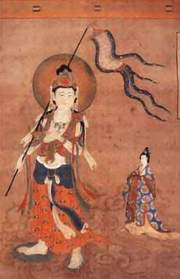|
| Related Stories |
 |
 |
|
|
History of Dunhuang  |
|
|
The history of Mogao Grottoes dates back to 366 A.D. According to legend, a wandering monk, Yue Zun, arriving at the oasis below the cliffs, saw myriad golden lights on Mount Sanwei, as though thousands of Buddhas were giving off beams of lights. He then began to carve grottoes into the sandstone cliff and fill them with these Buddhist images. Thus started a Buddhist way station on the Silk Road, and also the long history of Dunhuang Mogao Grottoes…
Northern/Western Wei / Zhou Dynasty Period (386-557 A.D.)

From the Six Dynasties (or Northern and Southern partition) Period to the Northern and Western Wei Periods, 23 caves were created, reflecting the characteristics of India, the cradleland of Buddhism. The facial features of the sculptures of this period are broad faces and prominent cheeks, fine eyebrows, thin lips, high-set nose, and the body is generally slender and draped in a light clinging robe.
The paintings that adorn the cave walls illustrate parables and stories of Buddha’s life. The ceilings are decorated with geometric patterns, animals and legendary figures from Chinese mythology.
The Zhou Dynasty Period caves have the same general characteristics as the Wei. During this period, the caves were constructed by the Turkic-speaking Tobas who formed the Wei Dynasties. They adopted Chinese manners and customs.
Sui Dynasty (581-618 A.D.)

Ninety-five caves were built during this period. The unique Indian influence is gone, and the statues are often in the sitting position, the faces express greater warmth and humanity, less majesty and the clothing is more softly draped. The faces are fuller, with the ear lobes longer and the body halves are not always proportional. Ananda and Kashyapa, disciples of the Buddha are sculpted for the first time.
The paintings are rich in composition and design. The theme remains the life of the Buddha, but the garments are now ornately decorated, with the men wearing Chinese clothes and the women wearing slim robes with narrow sleeves. Sui artists have in some caves painted over the work of the Wei artists.
Tang Dynasty (618-907 A.D.)

Tang Dynasty reached Dunhuang's peak artistic achievements, during which 213 caves were hewn from the sandstone cliffs. The figures are more realistic. The small wall niches, which in earlier years were places for statues, became small rooms, some having multiple levels. Two large Buddhas were carved, one being 100 feet and another 75 feet high.
The paintings in this time also tell the stories of the Buddha, and include pictures of Bodhisattvas, as well as the images of Tang Dynasty nobles and aristocrats. The influence of Persia and India is seen in the often-recurring mandalas. Multi-limbed and eyed statues appeared by the end of this period.
Later Dynasties

During the Five Dynasties (907-960 A.D.) and Song Dynasty (960-1279 AD) Periods, the inhabitants began to enlarge some of the caves and completely transform others. Thirty-three caves were made during the Five Dynasties, 98 from the Song Dynasty and three from the Western Xia (or Xi Xia) (1038-1227 A.D.). The most outstanding is a wall mural that depicts the main features of the terrain from Taiyuan in Shanxi Province to Zhenzhou in Hebei Province, including over 100 structures standing at the time in the Wutai Mountains.
The artwork is repetitive, and lacks the vitality of earlier eras. It is during this time that the Mogao Grottoes became an artistic backwater.
During the Mongolian Yuan Dynasty (1271-1368 A.D.), nine new caves were cut into the north face of the cliff. These caves are small and represent Mongolian style. Also large frescoes were painted, many of the figures representative of the Tibetan pantheon.
The Ming Dynasty (1368-1644 A.D.) and the Qing Dynasty (1644-1911 A.D.) made no advances, most of the artists just worked for redecoration.
Editor: Rebecca & Ronnie
Source: CCTV.com
|
|









